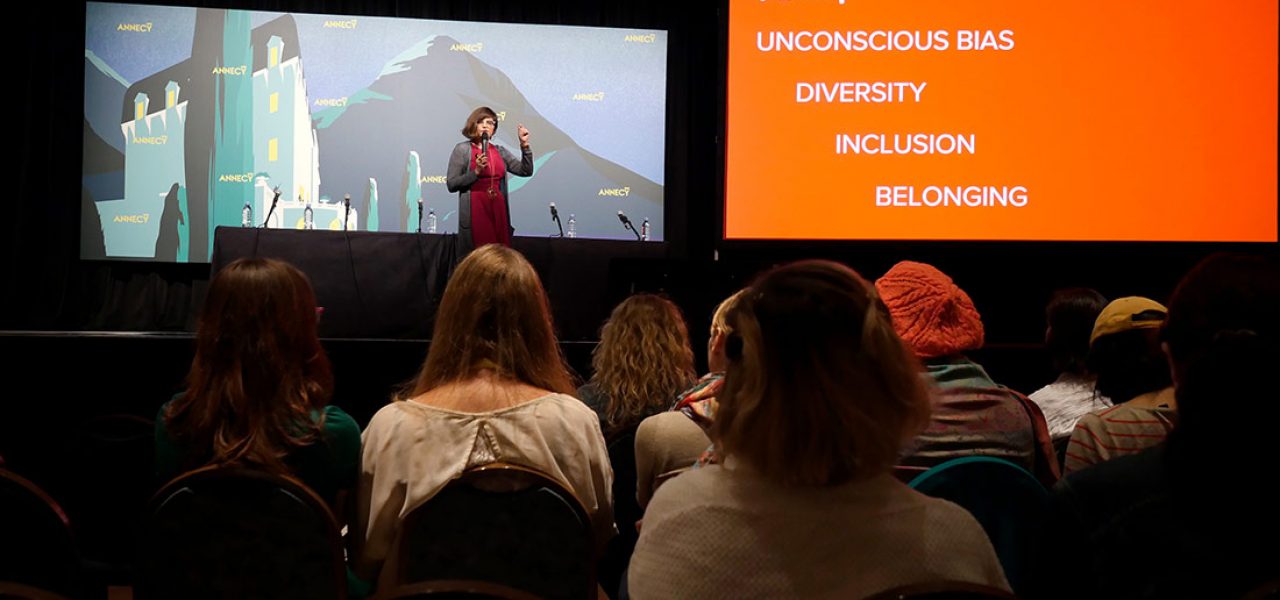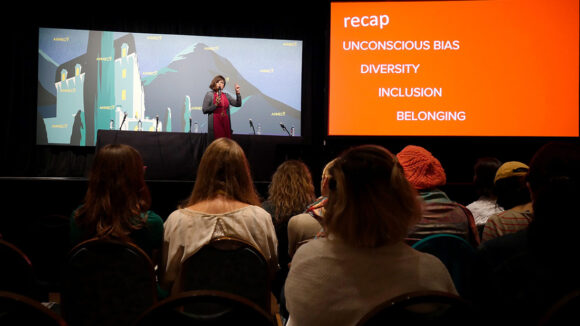

Annecy: 4 Things That Animation Studios Can Do To Create A Culture Of Belonging
On Monday, Women in Animation and Les Femmes s’Animent, with the help of sponsors such as Walt Disney Animation Studios, Dreamworks, and Netflix, presented the second annual Women in Animation (WIA) World Summit at Annecy International Animated Film Festival.
The day-long event consisted of a keynote presentation on inclusion and intersectionality by WIA secretary Julie Ann Crommett, who in her day job is v-p of multicultural audience engagement at Walt Disney Studios, as well as four other panels featuring conversations on the current status of women working within the animation industry and plans for the future.
Chief among these plans was of course WIA’s own initiative to ensure 50/50 gender parity in the animation industry by 2025, a crucial goal far from the current reality, especially for the industry’s key creative roles. For example, from 2010 through 2017, 91 out of 92 major U.S. animated releases had at least one male director.
Gender imbalance within the animation industry and the wider film industry, of course, is an issue that disproportionately affects women of color — of each year’s top 100 films from 2007 to 2017, only four percent of films were directed by women, while only eight directors of all 1,223 were females from an underrepresented racial or ethnic group.
In her introductory presentation, which also stressed how inclusive and diverse creative content can positively affect a company’s bottom line, Crommett emphasized that “being invited to the party” is only one step toward the ultimate aim of creating a workplace environment where everyone feels that they belong and that their voices are heard and heeded.
Here are some actionable takeaways from Monday’s discussions that can improve the working lives of everyone at an animation company and help build a better future for the industry.
1. Enact hiring practices that prevent unconscious bias from affecting decisions
Crommett cited an example from the music world in order to drive home a point about unconscious bias. In 1970, the top five orchestras in the U.S. were composed of fewer than five percent women. This number has been steadily rising due to the popularity of the blind audition, a practice that has been shown to increase a woman applicant’s chances to make it to the final round by 50 percent. Crommett suggested that in order to eliminate processes that are hurting your organization, it’s critical to first identify ways bias can creep in without anyone being explicitly aware.
“It’s really about knowing and sharing your data,” said Crommett. “I want you to really think about, ‘What’s that data that I need to know, to understand, so that I can go back and re-evaluate the decisions I’ve made?’”
2. Demand responsibility and awareness from business partners
Anthony Leo, co-president of Aircraft Pictures, speaking on the “What 50/50 Means to Allies” panel, said that when looking to achieve gender parity on the production of Hulu’s Holly Hobbie, he ran into some issues with agencies.
“We said [to this agent], ‘Well, if you have any female directors, we’d love to take a look at them.’ And they were kind of taken aback a little bit, because they had no female directors. The call was pretty short,” said Leo. “[Hopefully] that leads to that agent talking to schools and saying, ‘Send me some prospects that are female, because that’s what I’m really looking for.’ That’s how it starts happening, so you’ve really got to make that effort.”
3. Establish a no-interruption policy
In response to two young women writers pointing out that they were disproportionately interrupted by men in story meetings for the live-action tv series The Shield, showrunner Glen Mazzara established a policy banning interruptions by anyone, male or female, in meetings. What the team then found was that the meeting atmosphere became not only more just, but also more efficient.
“[Mazzara] said it had become the best meeting room he’d ever had in his life, so he’s done it on every show since,” said Crommett, again illustrating her argument with a real success story. “By making a rule that actually helped improve the experience for the most affected group in the room, he made it better for everybody. When you’re thinking about your meeting rooms, or places where you can actually change the rules to make it more inclusive for everybody, think about… how do we lead the room differently so everybody has a voice?”
4. Create a mentorship program for female staff
Cara Speller, executive producer at London-based Passion Animation Studios, and Andrea Miloro, co-president of Fox Animation, both on the “Developing Diverse Talent” panel, expressed the intent to establish mentorship programs to support female employees and even potential employees.
Speller said she had noticed a concerning trend in lack of confidence among women, especially in students. When her company put out an open call for students at the Royal College of Art in London to join Passion Presents, a roster of exciting young talent, she was shocked by the lack of response from women.
“We know [the RCA] has at least 50 percent female students in the course. We didn’t have a single response from a female student. And the male students responded instantly, within a day, two days, three days,” said Speller. “We had to actually go after every single female student and say, ‘We haven’t heard from you. Are you sure you’re not interested in this?’ It took an awful lot of encouragement. There was so much doubt in themselves that they had to get over. I think we need to do everything we can to stop that.”
Photo at top: E. Perdu/CITIA.

.png)